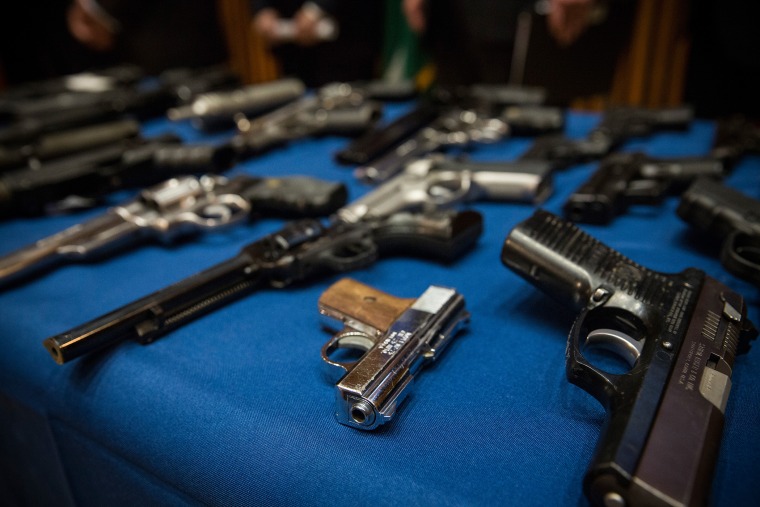For the past year, reporter Michele Richinick has chronicled the lives of more than 50 children under the age of 18 who lost their lives to gun violence. In an interview with msnbc.com, Richinick explains how the Too Young to Die series developed and what she hopes readers have come to understand about the toll of gun violence on the country’s young. What follows is a condensed and edited version of a conversation with Community Editor Gabriela Resto-Montero.
GRM: What spurred you to start this series?
MR: After the Sandy Hook tragedy where 20 first-graders were killed, msnbc decided to look at some of the many other children who have been killed by guns in America. And we thought about what age groups to include. It’s not an all-encompassing series; there are many more children who've died who aren't included. But I've tried to show an array of children across the country--different regions, rural and urban, different ethnicities and backgrounds--to paint a broad picture of gun violence in America.
It was hard at first to tell people what I was doing because we didn’t have other stories to show them, so I think they were questioning where I was going with this. But it’s gotten easier, since now families can see how their story will look and what our approach is. They know that I’m not asking for details of the crime or the death--it’s really a focus on the child’s life.
Let’s talk about that--because readers have asked why we're not focusing on how these children died.
The first draft I wrote was about Alfreddie Gipson, and as I gathered facts, I got the police report from his local police department in Memphis. Then I wrote up a draft and discussed the story with my editors, and it turned out we all disliked that version. It seemed like just another news article that you would find in the local paper or on TV. We wanted to make it different, make the series something that you can’t find anywhere else. So we decided to focus my interviews with the families more on specific questions about the child--what they were like, what they enjoyed doing, what their favorite things were—and within those questions really find one or two things to focus on. They’re not long feature stories, they’re about 200-, 300-word vignettes of the child’s life.
Why not focus on how they were killed? Isn't the issue of gun violence the point?
I note how the child died at the end of each piece. Putting those details last really allows the readers, I think, to focus on what that child did, how that child contributed to society while he or she was alive, and what society lost with each of these children’s deaths. As awful as Newtown was, the 20 children that were killed there, there are so many more like them every day—about four children are killed every day, and those children aren’t--their names aren’t being read aloud at memorial services. But they had just as much to contribute as anyone else.
Have you noticed a theme that every family you speak with wants you to share? Is there something that they all have in common, apart from the tragedy of a child's death?
Well, obviously, each child is different. I remember Braydion Matlock loved to act as Spiderman. He went around swinging from curtain to curtain. And Alfreddie Gipson loved making blueberry pancakes with blueberry syrup. Alexandra Brown loved working with animals at her local animal shelter. So they're unique. But in a lot of stories, the mother or father told me, “Our child never forgot to say 'I love you.'” Or the parents may not use those words but found a way to tell me. Even the ones who were older, the ones who were 16- or 17-years-old, in helping out with chores or doing their deeds around the house, they’re all really innocent lives.
Also, I just want to say too, that no matter how the child died—there are suicides in the series; there are some that might have been involved in a conflict—but no matter how they died or what they were doing at the time of their death, it’s still a child’s life lost.
That’s something that a lot of commenters have been critical of, saying, “Well, these kids were involved in gangs, they were criminals.” Has that been your experience?
Parents aren’t going to say, “My child was a gang member.” And even if that is the case, that’s not something I focus on--again, it's still a young life lost.
What’s your goal for people to take away from this series? What do you hope the impact is?
Having more education about guns. A lot of these families tell me they’re pro-gun and they own multiple guns. So it’s not about whether you’re pro- or anti-gun with this series, it’s about gun safety. In a lot of these stories, the child was killed accidentally on a hunting trip. Or the child was a teenager and was taught about gun safety but, on impulse, pulled the trigger. So if you are going to have a gun in the home, you need to know about safety. But also, just more generally, I just want to convey that every child had his or her own qualities to offer the world.
We gave this series the title "Too Young to Die" because all of them--some were 17 and some weren't even a year old--weren't able to fully live out their lives. On a national level it might seem small but to these individual families and communities, their loss is felt very deeply.
